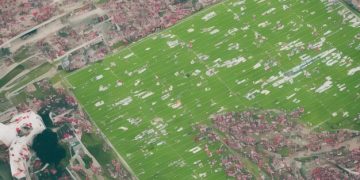NFL Offseason Training: Latest Innovations and Techniques

NFL offseason training programs are constantly evolving, integrating cutting-edge innovations in sports science, technology, and recovery to prepare athletes for the rigorous demands of the upcoming season.
The NFL’s offseason training programs have undergone a significant transformation in recent years. We will explore the latest innovations reshaping how players prepare, recover, and elevate their performance for the grueling NFL season.
Evolving Strategies in NFL Offseason Training
NFL offseason training is no longer just about lifting weights and running drills. It is now a sophisticated, data-driven process that focuses on maximizing player performance while minimizing the risk of injury.
The modernization of offseason training reflects a broader trend in professional sports towards more scientific and holistic approaches to athlete development.
Data Analytics and Performance Metrics
Teams are leveraging data analytics to gain deeper insights into player performance. Sophisticated tracking systems and wearable sensors provide real-time data on metrics such as speed, acceleration, heart rate, and biomechanics.
This data enables trainers to tailor workouts to the specific needs of each player, optimizing their training regimen for maximum effectiveness.
Personalized Training Programs
Gone are the days of one-size-fits-all training programs. Today, NFL teams are creating highly personalized training plans based on individual player profiles.
These programs take into account factors such as player position, injury history, strengths, and weaknesses to ensure that each athlete receives the specific training they need to excel.
- Position-Specific Drills: Tailored exercises that mimic the movements and demands of a particular position.
- Strength and Conditioning: Customized strength training routines designed to build power, agility, and endurance.
- Rehabilitation Programs: Targeted rehabilitation protocols for players recovering from injuries, focusing on restoring strength and function.
In conclusion, NFL teams are now utilizing data-driven and personalized training programs to enhance the performance and longevity of their players during the offseason.

Advanced Rehabilitation and Injury Prevention
Injury prevention is a top priority for NFL teams, and offseason training programs are designed to mitigate the risk of common football injuries.
Advanced rehabilitation techniques and proactive injury prevention strategies are now integral components of offseason preparation.
Cutting-Edge Recovery Techniques
NFL teams are investing in state-of-the-art recovery technologies to help players bounce back from strenuous workouts and minimize muscle soreness.
These techniques include cryotherapy, massage therapy, compression therapy, and nutrient optimization. By promoting faster recovery, players can train harder and more effectively.
Biomechanical Analysis and Movement Screening
Biomechanical analysis involves assessing a player’s movement patterns to identify potential weaknesses or imbalances that could lead to injury.
Movement screening helps trainers pinpoint areas where players may be at risk and implement corrective exercises to improve their mechanics and reduce the likelihood of injuries.
- Cryotherapy: Exposure to ultra-cold temperatures to reduce inflammation and muscle soreness.
- Massage Therapy: Manual manipulation of muscles to promote relaxation and improve blood flow.
- Compression Therapy: Using specialized garments to enhance circulation and reduce muscle fatigue.
In essence, advanced rehabilitation techniques and injury prevention strategies aim to keep players healthy, resilient, and ready to perform at their best during the NFL season.
The Role of Nutrition and Hydration
Proper nutrition and hydration are essential for optimizing player performance and recovery during the offseason.
NFL teams are placing a greater emphasis on educating players about the importance of fueling their bodies with the right nutrients and staying adequately hydrated.
Personalized Nutrition Plans
Registered dietitians work with players to develop personalized nutrition plans that align with their individual needs and training goals.
These plans take into account factors such as player size, body composition, activity level, and dietary preferences to ensure that they are getting the nutrients they need to support their training.
Hydration Strategies
Maintaining proper hydration levels is crucial for preventing muscle cramps, fatigue, and other performance-limiting issues.
NFL teams provide players with access to a variety of hydration options, including water, sports drinks, and electrolyte-rich beverages. They also educate players about the importance of drinking fluids throughout the day, especially during workouts.
In summary, nutrition and hydration strategies are key components of NFL offseason training programs, ensuring players are well-fueled, hydrated, and prepared to perform at their highest levels.

Mental Conditioning and Cognitive Training
Mental toughness is a critical attribute for NFL players, and offseason training programs now incorporate mental conditioning and cognitive training exercises to enhance players’ focus, decision-making, and resilience.
These techniques are designed to help players perform under pressure and overcome adversity on the field.
Mindfulness and Stress Management
Mindfulness practices, such as meditation and deep breathing exercises, can help players stay calm and focused in high-stress situations.
Stress management techniques, such as visualization and positive self-talk, can help players cope with the demands of the game and maintain a positive mindset.
Cognitive Skills Development
Cognitive training exercises can improve players’ reaction time, decision-making abilities, and overall cognitive performance.
These exercises often involve using computer-based games or simulations that challenge players to think quickly and make accurate decisions under pressure.
- Visualization: Mentally rehearsing successful plays and outcomes to build confidence and reduce anxiety.
- Neurofeedback: Using brainwave feedback to optimize brain function and enhance focus.
- Game Simulation: Practicing game situations in a controlled environment to improve decision-making skills.
In brief, mental conditioning and cognitive training are becoming increasingly important components of NFL offseason training programs with the aim of cultivating mental fortitude, improving cognitive performance, and enabling players to excel under pressure.
Embracing Technology in Offseason Workouts
Technology is playing an increasingly important role in NFL offseason training programs, with teams using a variety of high-tech tools and devices to track player performance, analyze biomechanics, and optimize training regimens.
Wearable sensors, virtual reality simulations, and advanced video analysis systems are just a few of the technologies being used to give players a competitive edge.
Wearable Sensors and GPS Tracking
Wearable sensors, such as GPS trackers and heart rate monitors, provide real-time data on player performance metrics, such as speed, distance, acceleration, and heart rate.
This data can be used to track player workload, identify areas for improvement, and optimize training intensity. GPS tracking allows teams to monitor player movement patterns and ensure that they are covering the necessary ground during workouts.
Virtual Reality Training
Virtual reality (VR) is revolutionizing the way NFL players train, enabling them to practice game situations in a simulated environment.
VR training allows players to make decisions and react to different scenarios without the risk of physical contact. This technology is particularly useful for quarterbacks, who can use VR to practice reading defenses and making split-second decisions.
In short, NFL teams are increasingly embracing technology to enhance player performance during their offseason training programs by optimizing data-driven performance metrics and simulations.
The Importance of Rest and Recovery
While intense training is essential, adequate rest and recovery are equally crucial for optimizing player performance and preventing injuries in the NFL.
NFL teams are placing a greater emphasis on providing players with ample opportunities to rest, recover, and recharge during the offseason.
Sleep Optimization
Sleep is essential for muscle recovery, cognitive function, and overall health. NFL teams are educating players about the importance of getting adequate sleep and providing them with resources to improve their sleep habits.
These resources may include sleep tracking devices, sleep hygiene education, and access to sleep specialists.
Active Recovery Strategies
Active recovery techniques, such as light exercise, stretching, and foam rolling, can help reduce muscle soreness and promote blood flow, helping players recover from workouts more quickly.
NFL teams often incorporate active recovery sessions into their offseason training programs.
- Sleep Hygiene: Maintaining a consistent sleep schedule, creating a relaxing sleep environment, and avoiding caffeine and alcohol before bed.
- Foam Rolling: Using a foam roller to massage muscles and release tension.
- Hydrotherapy: Using water-based therapies, such as hot and cold baths, to promote circulation and reduce inflammation.
In conclusion, giving ample rest and recovery opportunities is essential for NFL athletes as they gear up for the season ahead.
| Key Point | Brief Description |
|---|---|
| 📊 Data Analytics | Teams utilize data to personalize training and optimize performance. |
| 💪 Injury Prevention | Advanced rehab and movement analysis to reduce injury risk. |
| 🍎 Nutrition & Hydration | Personalized plans support performance and recovery. |
| 🧠 Mental Conditioning | Techniques to improve focus, decision-making, and resilience. |
FAQ
▼
The primary goal is to prepare players physically and mentally for the demands of the upcoming NFL season, which involves maximizing performance and minimizing the risk of injuries.
▼
Teams use data analytics, player position, injury history, and individual strengths/weaknesses to create highly tailored training plans designed to meet the specific needs of each athlete.
▼
Technology like wearable sensors, GPS tracking, and virtual reality simulations are used to provide real-time data, analyze biomechanics, and optimize training regimens for competitive efficiency.
▼
Proper nutrition and hydration are essential for optimizing player performance, supporting recovery, and ensuring that players have the energy and nutrients they need to train effectively.
▼
Mental conditioning includes mindfulness, stress management, visualization, neurofeedback, and game simulations to enhance focus, decision-making, and resilience under high-pressure situations.
Conclusion
The NFL’s offseason training programs have evolved significantly, incorporating innovations in data analytics, rehabilitation, nutrition, mental conditioning, and technology. By embracing these advancements, teams aim to optimize **NFL offseason training programs** for performance, minimize injury risk, and ensure players are well-prepared for the rigors of the NFL season.





